When it comes to virtual reality we’re all excited, but we know that There are many technical problems to address. First of all, the size; because devices don’t have to be difficult to wear for a long time. Even if they are small, they need heavy batteries if not even of a cable, in which we will punctually get entangled. Finally, virtual reality devices need computing ability, and therefore a CPU, so they will heat up. If all this happens then in something that we have in mind, our tolerance drops to a minimum. However, Qualcommwith its new Snapdragon processors XR2 Gen 2 e AR1 Gen 1designed specifically for virtual and augmented reality, may be able to change this situation.
Qualcomm XR2 Gen 2 e AR1 Gen 1
The two processors presented by Qualcomm were thought from the beginning to allow us to enjoy a unprecedented virtual reality. The two processors are small and lightoffer a lot of processing capacity superior to the previous generation and, all this, with energy consumption extremely more efficient. In other words; They don’t weigh us down, they can process a lot of data, they need little energy and heat very little. We could say that if we really have to a device on your head for hoursthese new Snapdragons are definitely a good choice.

XR2 Gen 2: High-performance immersion
L’XR2 Gen 2 by Qualcomm is designed to be the beating heart of a viewer for virtual and augmented reality. First, it promises excellent graphic rendering without sacrificing energy efficiency. Indeed, it includes a graphics system, a GPUwhich compared to the first generation offers more than double the performance. This means we will have more vivid colors e more frames per second with an optimized resolution of 3K per eye.
Sign up for Amazon Prime here for free. You have 30 days trial!
Another aspect on which XR2 puts an extra gear is tracking of our position. Which is not secondary, because you delay or even minimal errors between our moving head and the image that is shown to us can be cause of motion sickness. Location tracking has been greatly enhanced by Qualcomm thanks also to an artificial intelligence module present inside the CPU.
The detection, however, it doesn’t stop at the movement of the head. XR2 is capable of using a series of sensors to detect user parameters such as the position of the eyes and the movement of the face. This information can be applied to our avatar to make theinteraction between users of a virtual environment much more realistic.
As if what we’ve already seen wasn’t enough, the XR2 It also supports up to ten cameras point towards the outside of the viewer. The cameras scan the environment and detecting objects and surfacesthe. It is also possible to do that way augmented realitywhere there are digital objects superimposed on the real world.

AR1 Gen 1: to wear without problems
Virtual reality is certainly a futuristic technology but it also has a no small problem: the size. Indeed we must wear a helmet to have the two projectors in your eyes. It may make sense in an office or during leisure, but it turns out difficult to use for daily tasks.
Lo Snapdragon AR1 Gen 1 of Qualcomm also wants to break down this wall. In fact, it was designed to be used not in a helmet but in a pair of glasses. The same glasses, more or less, that many of us have on the nose always every day.
Obviously, with a system like this, we can do it only augmented reality. However, think about the convenience; while we are riding a bicycle the overlay road indications. Or, when we talk to a person in a language we don’t know they appear to us real-time subtitles. The potential is almost endless.
However, what we gleaned from Qualcomm’s presentation is an even more interesting goal: dematerialize the phone and put it in the temples of our glasses. Not surprisingly, AR1 supports professional quality audio and video to allow us to listen to music and record every moment of the day while keeping our hands free. The phone’s display transfers to the lenses of the glasses and Qualcomm also makes it available to us all the connectivity we need. In fact, via AR1 it is possible to use both Bluetooth 5.3 is WiFi 7. The only thing missing, for now, is making phone calls independently. But with eSims and 5G upon us, we feel like saying that it could be a matter of time.
Not just processors, but also products
We’re used to seeing ads about technology and then having to wait a very long time to have the first products in hand. Qualcomm, on the other hand, he surprised us on this too. In fact, he also announced at the same time that they will be put on the market soon il Meta Quest 3 con Snapdragon XR2 Gen 2 e Ray Ban Stories which will use Snapdragon AR1.
At Meta we are focused on developing future technologies in mixed reality and smart glasses, as well as the foundational innovations that will one day power our vision of augmented reality glasses.
Andrew Bosworth, Meta CTO and Head of Reality Labs
During the presentation the company talked about one possible release in 2023. However, considering that we are already in autumn, in the editorial team we are more inclined to think about the beginning of 2024. However, we do not exclude that Qualcomm, with the help of Meta, could surprise us a second time.
For the curious, Qualcomm delivers lots of interesting information on its site for both the XR2 Gen 2 and the AR1 Gen 1.















Leave a Reply
View Comments